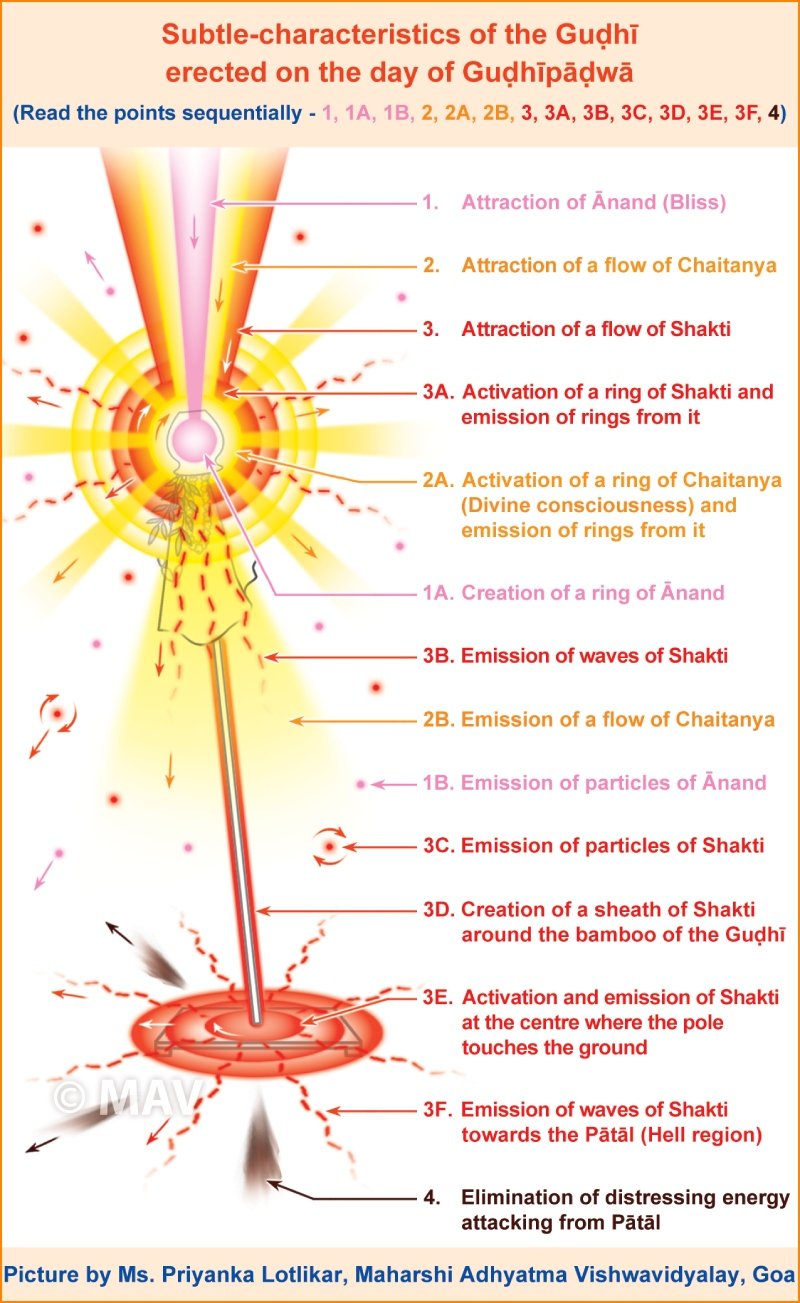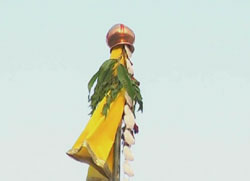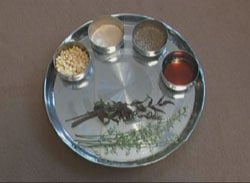Contents
- Introduction
- Science in the worship of the Gudi
- Method of raising the Gudi
- Prayer
- Shun Materialism, insist on ‘Dharmachar’ !
- Significance of Gudi Padwa
- The method of celebrating Chaitra Shukla Pratipada
Videos on ‘ How to celebrate Gudipadwa? ‘
Also available in Kannada & Telugu
Introduction
Gudi Padwa, the first Holy festival which marks the beginning of the New Year, new month and new day for the Hindus falls on Chaitra Shukla Pratipada. ([festival_date festival=gudipadwa]) It is known as Gudhi Padwa (in Maharashtra), Ugadi (in Karnataka, Andhra Pradesh). [In other parts of country it is celebrated during Nau Roz (Kashmir), Baisakhi (Punjab), Cheti Chand (Sindhi), Naba Barsha (Bengal), Goru Bihu (Assam), Puthandu (Tamil Nadu), Vishu (Kerala)] On this very day Lord Brahma created the Universe. Therefore for Hindus, this day carries special importance. The day is celebrated with an auspicious bath, followed by decorating the doorway with a ‘toran’, performing ritualistic worship and hoisting the Gudhi.
Gudhi Padwa is celebrated as Ugadi (or Yugadi) in Karnataka and Andhra Pradesh. The day, begins with ritual showers (oil bath) followed by pooja to god and Panchanga Shravana.Houses are decorated with Mango Leaves and Rangoli and everyone in the family wear new clothes and celebrate the festival by wishing each other New year greetings.
The eating of a specific mixture called Bevu-Bella (Neem and Jaggery) in Kannada, symbolizes the fact that life is a mixture of good and bad, Happiness and Sorrow. Eating Neem and Sweet Jaggery means one need to take both Good and Bad or Happiness and Sorrow should be accepted together and with equanimity through the New Year. The special mixture consists of:
-
Neem Buds/Flowers for its bitterness, signifying Sadness
-
Jaggery which is sweet, signifying Happiness
In Karnataka a special dish called Obbattu or Holige (Puran Poli), is prepared on this occasion. It consists of a filling (gram and jaggery/sugar boiled and made in to a paste) stuffed in a flat roti like bread. It is usually eaten hot/cold with ghee or milk topping or coconut milk at some places of Karnataka.
Science in the worship of the Gudi
 ‘Gudi Padwa’ is the day on which the universe was created. Since on this day Shri Brahma created the universe and the Satyayug began, it marks the commencement of the New Year.
‘Gudi Padwa’ is the day on which the universe was created. Since on this day Shri Brahma created the universe and the Satyayug began, it marks the commencement of the New Year.
The Divine consciousness emanating during sunrise, absorbed at that time lasts longer. Thus the Gudi should be worshipped within 5-10 minutes after sunrise !
On Gudi Padwa, the waves consisting of the fire principle (Tej tatva) and the creative Prajapati waves are activated on a large scale. The Divine consciousness emanating during sunrise, absorbed at that time lasts longer. This consciousness is stored in the body cells and is used as required. Hence the Gudi should be worshipped within 5-10 minutes after sunrise.
Method of raising the Gudi
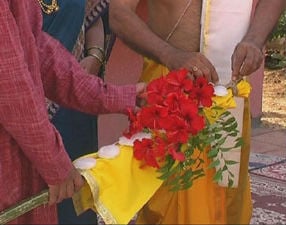 Position of the Gudi : Care should be taken to raise the Gudi next to the main entrance of the house. The spot selected should be on the right side of the entrance(when facing outwards from the entrance of the home). The right side symbolizes the active state of the soul.
Position of the Gudi : Care should be taken to raise the Gudi next to the main entrance of the house. The spot selected should be on the right side of the entrance(when facing outwards from the entrance of the home). The right side symbolizes the active state of the soul.
1. The area selected for raising the Gudi should be cleaned and then a Swastik rangoli should be drawn on the ground. Turmeric and vermilion (Haldi-kumkum) should be offered at the centre of the Swastik.
2. While raising the Gudi, the ‘Shiva-Shakti’ principle in the Universe should be invoked. This enables all the constituents of the Gudi to accept divine principles.
3. The Gudi symbolizes the ‘Sushumna nadi’ of our body. Hence, the Gudi should be raised at the entrance. And it should be kept tilted at an angle. – A Scholar (through the medium of Ms. Anjali Gadgil)
Prayer
‘O Lord Brahma, Lord Vishnu ! Please enable me to absorb the Principle of Creation and the Fire Principle present in the atmosphere. Let the Divine consciousness present in these principles be preserved constantly. Let the energy thus received, be used for my spiritual practice.’
Reason for raising the Gudi during war
The Gudi is a symbol of victory. Amongst the various qualities of God, ‘Being Victorious’ is one and it symbolizes that God has achieved victory at the outset and at various levels. To symbolize this at every level of war, a Gudi is hoisted.
Do not be misled by anti-Dharma propaganda
A few heretic elements indulge in spreading communal and misleading propaganda that ‘Chhatrapati Sambhaji Maharaj was killed and his head was mounted on the tip of a lance and displayed around. Therefore, the Brahmans started celebrating Gudhipadwa. This divided the Hindu society. Since Hindus are not getting any education on Dharma, some Hindu brethren are unfortunately falling victim to this propaganda. They should realise some aspects given ahead –
- In the Adiparva of Mahabharat, which was written thousands of years ago, the shloka 18 to 22, a reference of erecting Gudhi clearly exists.
- In the Owis written by Sant Dnyaneshwar in the 11th century, the mention of Gudhi is found.
- In the 14th century Sant Chokhamela said, “Erect Gudhi and clap while taking a journey to Pandharpur”.
Thus, it goes to prove the propaganda that Gudhipadwa started after the killing of Chhatrapati Sambhaji Maharaj 350 years ago is totally misleading and false.
From last few years, since Hindus did not pay any heed to misleading propaganda, a new method to divert the practice to celebrate Gudhipadwa by hoisting the saffron flag instead of Gudhi is being spread. Actually, the Hindus should hoist the saffron flag on the house for 365 days a year instead of only on Gudhipadwa. Thus, the propaganda to hoist saffron flag in place of Gudhi is a sinister conspiracy to stop the celebration of Gudhipadwa. Therefore, Hindu janajagruti Samiti advises, ‘Erect the Gudhi on Gudhipadwa, and along with it hoist the saffron flag on the house for the entire year.
Similalrly, misleading information is also spread about the religious rituals connected with Gudhi such as to keep the pot upside down on Gudhi is a bad omen, to hoist sari is like displaying one’s character, etc. It is ridiculous that those who basically oppose the Hindus’ religious traditions, oppose the rituals should talk about piety, etc.
O’ Hindus, Abide by traditions of Dharma with full faith without falling victim to misleading propaganda, appeals Hindu Janajagrtui Samiti.
Shun Materialism, insist on ‘Dharmachar’ !
Chaitra Shukla Pratipada is a sacred day for the Hindus. In some parts, it is observed as New Year’s Day. At the end of a year and the beginning of a New Year, it is necessary to ponder over what were the developments with respect to Sanatan Dharma. It is observed that there was a remarkable increase in the onslaughts on Dharma and only a few came forward to oppose these. Neither the onslaughts on Dharma, nor the weak opposition to it by Hindus are new problems for awakened Hindus. The most serious opposition faced by awakened Hindus in the past year was from the so-called pro-Hindu Organisations.
No one should preach about freedom with regards to Sanatan Hindu Dharma, which teaches respect for every living being on the earth. There should be a difference between freedom and wanton behaviour. However, not only the common man but even those who profess to be the champions of Hindutva, make mistakes in understanding the true meaning of wanton behaviour. An onslaught on culture is also wanton behaviour. Some awakened Hindus opposed the growing popularity of ‘pub culture’ for this reason. Pro-Hindu Organisations not only opposed them, but even demanded a ban. From this, it was clear that these are the pro-Hindu Organisations who instigate Hindus only to meet their own selfish ends.
Globalisation does not mean that we should discard our conscience and accept with open arms anyone who comes from across the seas, without giving a thought to the pros and cons of our action. Be it a ‘Valentine’s Day’, ‘pub culture’ or a weekly holiday, the pro-Hindu Organisations oppose those who protest such events; yet they hardly take any action in this regard. When there was a ban on bar girls in Maharashtra by the Congress, it was welcomed by others. Taking advantage of this, pro-Hindu Organisations should have tried to follow suit, but this did not happen.
Culture is a collective manifestation of Dharma. Hence, an attack on culture is an attack on Dharma. The ‘globalisation’, which is materialistic behaviour, attacks the local culture. And that is opposed by followers of other religions too in many parts of the world. Some countries have evolved special machinery in the Police to protect their culture. However, in Bharat there is no such machinery in existence.
The followers of other religions are so vigilant about their faith that their representatives may be in any political party, whenever an issue of their faith is raised, they all unite. The New Year is being ushered in with the message, ‘O Hindus! Arise !’ Religious interests are above a person or an Organisation. Therefore, learn what religious behaviour is, get spiritual experiences about Dharma and take action in the interests of Dharma. The situation has already gone out of control. Terrorism inspired by pan-Islamism ideology along with the veiled activities of missionaries who are inspired to spread their Gospel in third world countries like Bharat, in this century, are both attacks on Dharma. The cult of materialism is also a form of attack on our Dharma. It is difficult to decide which is more dangerous. With such forces looming large ahead of us and impacting our lives in so many ways, let us take cognisance of the dangers they pose and make a firm resolve to protect Dharma.
Let us resolve to educate ourselves about Dharma and also to impart it to others so as to awaken a love for Dharma in them. Organisations like Hindu Janajagruti Samiti and Sanatan Sanstha are already engaged in this noble task. They have taken the first step in this direction by organising Dharmajagruti Sabhas throughout Bharat.
Either you take some action in this regard on your own or participate in the activities of these Organisations. Instead of imbibing various aspects of a Western lifestyle into our personal lives, instil instead behaviour as taught by our Dharma. For example, children should be taught to say ‘Ma’ and ‘Pitajee’ etc. instead of ‘mummy’ and ‘daddy’. Inculcate pride for our language. Your resolve to take some action in the interests of Dharma will certainly bring you the blessings of Saints !
Significance of Gudi Padwa
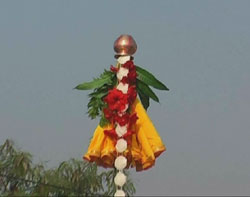 There are several ways of commencing a New Year. According to the Christian calendar, 1st January marks the beginning of the year. The financial year begins from 1st April, the Hindu New Year from the first day (Pratipada) of the month of Chaitra from the Hindu lunar calendar, the commercial year from the first day of the Hindu lunar month of ‘Kartik’, the solar (soura) year, the lunar (chandra) year, the luni-solar year and so on. In all these, the year comprises of twelve months. Who first proclaimed that a year should consist of twelve months and how did the world come to accept it ? The foremost exponent of this concept is undoubtedly the Vedas, the most ancient literary texts. The Vedas say, ‘A year consists of twelve months’. It is because they say so that the world has accepted it. Out of all these days of beginning a year the most ideal one is the first day of the month of Chaitra according to the Hindu lunar calendar.
There are several ways of commencing a New Year. According to the Christian calendar, 1st January marks the beginning of the year. The financial year begins from 1st April, the Hindu New Year from the first day (Pratipada) of the month of Chaitra from the Hindu lunar calendar, the commercial year from the first day of the Hindu lunar month of ‘Kartik’, the solar (soura) year, the lunar (chandra) year, the luni-solar year and so on. In all these, the year comprises of twelve months. Who first proclaimed that a year should consist of twelve months and how did the world come to accept it ? The foremost exponent of this concept is undoubtedly the Vedas, the most ancient literary texts. The Vedas say, ‘A year consists of twelve months’. It is because they say so that the world has accepted it. Out of all these days of beginning a year the most ideal one is the first day of the month of Chaitra according to the Hindu lunar calendar.
There are natural, historical and spiritual reasons to mark the commencement of the year on the first day of the month of Chaitra.
1. Natural : Towards the first day of the month of Chaitra (Padva), the sun assumes a position above the Vasant intersection (the point of intersection of the equator and the meridians) and the spring season commences. In Shrimadbhagvadgita (10.35), The Lord says, ‘Among the seasons, the exhilarating Vasant season (spring) is my manifestation’. In this season, the weather is pleasant and exhilarating. In the Shishir season (autumn) the trees shed their leaves. Towards Padva, trees bear new foliage and appear fresh.
2. Historical : Rama slayed Vali on this day. The Shakas too defeated the Huns on this day. This day also commemorates the commencement of the Shalivahan calendar after Shalivahan vanquished his enemies.
3. Spiritual
3 A. Creation of the universe : Since on this day Shri Brahma created the universe and the Satyayug began, it marks the commencement of the New Year.
3 B. One among the three and a half auspicious days (‘Muhurts’) : Gudhipadva, Akshay trutiya and Dasra (Vijayadashmi) each make up one, and the first day of the Hindu lunar month of Kartik comprises half of the total three and a half auspicious days. The special feature of these three and a half auspicious days is that unlike other days when one has to choose an auspicious moment to perform a ritual, in contrast, on these auspicious days one does not need to, as every moment of these days is auspicious.
3 C. The higher incidence of prajapati sanyukta (conjoint) frequencies on the earth : The tantra text Ganeshyamal states that in all 108 frequencies, one each from the four parts (charans) of the twenty-seven lunar asterisms from the region of lunar asterisms (nakshtralok / karmadevlok) 27×4=108 reach the earth. They disintegrate further into four types of frequencies – yama, surya, prajapati and sanyukta (conjoint).
On this day, the Tej and Prajapati frequencies are effective in large measures. During sunrise on this day, the Chaitanya (Divine Consciousness) emitted from these frequencies can be retained for a longer period. It is accumulated in the cells of the embodied soul and is used by the embodied soul as and when required. Therefore within 5-10 minutes of sunrise one should perform ritualistic worship of the Gudi.
The method of celebrating Chaitra Shukla Pratipada
‘One should narrate the description of the time period (‘deshkal’) when taking an oil bath. The manner of narration of the time period is peculiar among the Indians (Bharatiyas). This encompasses everything from the birth of Lord Brahma to the duration of His reign, the current ‘manvantar’, the great era (mahayug) in that ‘manvantar’ and the sub-era (‘upayug’) in that ‘mahayug’. This will also give one an idea of the vast amount of time that has elapsed and is yet to come. Each one thinks he is great. It is only after narrating this vast time frame of the universe that one realises how small and subtle one is ! This helps in reducing man’s vanity and is thus a great benefit.’ The scriptures have recommended an ablution with oil on five days of the year that is 1. The commencement of the New Year (sanvatsar).
A. The first day of the celebrations of the Vasant (spring) season, that is the first day of the dark fortnight of the month of Phalgun.
B. The three days of ‘Divali’, namely the fourteenth and the new moon day of the dark fortnight of the Hindu lunar month of Ashvin and the first day of the bright fortnight of the month of ‘Kartik’.
2. Decorating the doorstep : After a bath one should decorate the lintel of every door with a bunting of mango leaves and red flowers. Red flowers are used because red colour indicates auspiciousness.
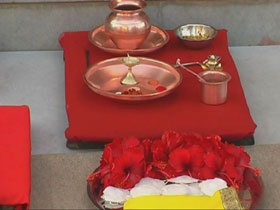 3. Ritualistic worship (puja) : First ritualistic worship of God as a routine ritual is done. ‘One should perform a ‘mahashanti’ on New Year’s day. The shanti begins with the worship of Lord Brahma, as He is responsible for creating the universe on this day. He is offered davna (a kind of fragrant plant) during the worship. Later a sacrificial fire (hom) and offering of oblations through the fire (havan) are performed and offerings to Brahmans are made. Then Lord Viíhnu who manifests Himself in countless forms is worshipped. Obeisance is paid to Him chanting the mantra meaning ‘I bow to Lord Vishnu who manifests in innumerable forms.’ Then the Brahmans are offered money or presents (dakshina) and if possible historical and mythological texts (Purans) are presented to them. It is beleived, that by performing this ‘shanti’ one is cleansed of all sins, no new sins are generated, the lifespan is increased and one becomes wealthy.’ (1) By performing a sanvatsar worship, all sins are cleansed, the lifespan is prolonged, a woman’s married life is prolonged and one acquires serenity. On this day, the Deity of that day of the week is also worshipped.
3. Ritualistic worship (puja) : First ritualistic worship of God as a routine ritual is done. ‘One should perform a ‘mahashanti’ on New Year’s day. The shanti begins with the worship of Lord Brahma, as He is responsible for creating the universe on this day. He is offered davna (a kind of fragrant plant) during the worship. Later a sacrificial fire (hom) and offering of oblations through the fire (havan) are performed and offerings to Brahmans are made. Then Lord Viíhnu who manifests Himself in countless forms is worshipped. Obeisance is paid to Him chanting the mantra meaning ‘I bow to Lord Vishnu who manifests in innumerable forms.’ Then the Brahmans are offered money or presents (dakshina) and if possible historical and mythological texts (Purans) are presented to them. It is beleived, that by performing this ‘shanti’ one is cleansed of all sins, no new sins are generated, the lifespan is increased and one becomes wealthy.’ (1) By performing a sanvatsar worship, all sins are cleansed, the lifespan is prolonged, a woman’s married life is prolonged and one acquires serenity. On this day, the Deity of that day of the week is also worshipped.
The following table gives the days of the week and the corresponding presiding Deity of that day.
| Sr. No. | Day | Deity of day |
|---|---|---|
| 1 | Monday | Shri Shankar |
| 2 | Tuesday | Parvati/Lakshmi/Ganapati |
| 3 | Wednesday | Pandurang |
| 4 | Thursday | Gurudev Datta |
| 5 | Friday | Parvati/Lakshmi |
| 6 | Saturday | Maruti |
| 7 | Sunday | Ravi (Sun) |
The table below compares the soothing effect of various substances. This will clarify why when the weather changes and summer begins ‘davna’ (a fragrant leaf) is offered in ritualistic worship everyday, in the month of Chaitra. Though both sandalwood and davna have the same ability to impart a soothing effect, sandalwood can do so only when it is wet unlike ‘davna’ which is effective throughout the day.
| Sr. No. | The substance | The ability to bestow a soothing effect |
|---|---|---|
| 1 | Chandrama (the moon principle) | 100 |
| 2 | Davna, Sandalwood | 1/1 lakh (1/1,00,000) |
| 3 | Vala (a grass with fragrant roots) | 1/10 lakh (1/10,00,000) |
| 4 | Ice | 1/1 crore (1/100,00,000) |
| 5 | Other substances | 1/10 crore (10,00,00,000) or even less |
4. Hoisting of the Gudi : The gudi, which is Brahma’s flag (Brahmadhvaj) is hoisted in every house as a symbolic representation of Rama’s victory and happiness on returning to Ayodhya, after slaying Ravan. Since a symbol of victory is always held high, so is the gudi (flag).
A bright green or yellow cloth adorned with brocade (zari) is tied to the tip of a long bamboo over which gaòhi (a type of sweet), neem leaves, a twig of mango leaves and a garland of red flowers is tied. This is then hoisted by placing a silver or copper pot placed in the inverted position over it. Beautiful designs with special powder of soft, white stone (rangolis) are drawn on the floor in front of it. Everyone eagerly waits to usher in the New Year. Then uttering the words, ‘I offer obeisance to the flag of Lord Brahma’ one should ritualistically worship the gudhi with a resolve. Since Lord Brahma created the universe on this day, this flag is called ‘the flag of Brahma’ (Brahmadhvaj) in the scriptures. Some also refer to it as ‘the flag of Indra’ (Indradhvaj).
The prajapati frequencies enter the house from the atmosphere using the gudhi as a medium. (This operates just like the antenna of a television set). The next day onwards one should use the pot for drinking water as it is charged with the prajapati frequencies and imparts the same kind of impressions to the water in it. Thus one gets the benefit of the prajapati frequencies throughout the year.
5. Listening to the religious almanac (Panchang shravan) : One should ritualistically worship the astrologer or priest and ‘listen to the benefits in the coming year. The benefits of listening to the religious almanac are as follows : ” By listening to the discourse on auspicious dates (Tithis) one acquires money (Lakshmi), by that of the day of the week – longevity; by that of lunar asterisms – nullification of sins; by that of the constellation – cure of disease and success in whatever one plans. Listening to the religious almanac daily endows the merit equivalent to bathing in the holy Ganga.”
6. An offering (Prasad) of neem : Since neem has the highest ability to absorb prajapati frequencies, on this day it is partaken of as an offering (Prasad). One should distribute this offering prepared by mixing together tender leaves and flowers of neem, soaked split gram lentil (dal) or soaked gram, honey, cumin seeds and a little of asafoetida amidst chanting of a mantra.
The following table gives the ability of certain substances to absorb frequencies. From that one will become cognisant as to why neem is partaken of on Gudhipadva day and milk, curd, clarified butter (ghee) and sugar are avoided in the month of Chaitra.
| Sr. No | The Substance | The ability to absorb frequencies (%) | ||
|---|---|---|---|---|
| Prajapati | Surya | Yama | ||
| 1 | Neem | 70 | 28 | 2 |
| 2 | Coconut, mango, bananas | 60 | 38 | 2 |
| 3 | Wild palm tree, coconut tree, cactii | 48 | 50 | 2 |
| 4 | Lilk, curd, clarified butter, sugar | 18 | 80 | 2 |
| 5 | Rice, wheat, jowar | 70 | 28 | 2 |
7. Ploughing the soil : On this day one should start ploughing the soil. As a result the soil below is churned up. The subtle soil particles get charged with the prajapati frequencies and its ability to germinate seeds increases manifold. Consecrated rice (akshata) should be sprinkled on the instruments used in farming and on the oxen amidst chanting of the mantra, which generates the prajapati frequencies. Labourers working in the fields should be gifted with new clothes. The meal given to the labourers and oxen on that day should comprise of ripe pumpkin, lentil (mung dal), rice, puran [gram lentil (dal) cooked till soft and ground to a paste with jaggery], etc.

